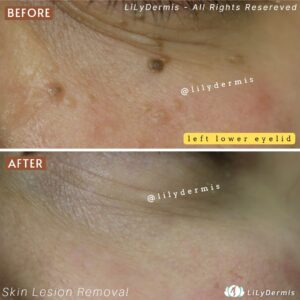What is Syringoma?
Syringomas are harmless, benign sweat ducts tumors. They are most commonly seen around the eyelid area and upper cheeks. Rarely they may also occur on the chest, abdomen, armpits, umbilicus, or genitals. They usually begin to develop in young adulthood but can occur at any age. Syringomas are often mistaken for other skin conditions such as milia, xanthelasma (cholesterol deposits), sebaceous hyperplasia, acne vulgaris, flat warts, lichen planus, or basal cell carcinoma.
Causes of syringomas:
These harmless growths result when the cells from your sweat glands are overactive. These benign tumors lie in the mid to deep dermis of the skin. Some conditions affect the sweat glands and may develop syringomas. These include:
- Diabetes Mellitus
- Ehlers-Danlos syndrome
- Genetics
- Down syndrome
- Marfan’s syndrome

Signs and symptoms of syringomas:
Syringomas are small yellow, brown, or pale pink bumps that grow between 1-3 millimeters. The papules usually grow in small groups which tend to be symmetrical. Syringomas aren’t itchy or painful and are usually asymptomatic.
Prevention:
Factors that may reduce the risk of syringomas include:
- Using sunscreen and avoiding the skin from UV rays may help reduce the risk of syringomas
- Using acidic exfoliating facial cleansers
- Using acidic astringents or facial toners
- Making sure blood sugar levels are in a normal range
- Avoiding skin irritants and allergens
- Eating a healthy and balanced diet high in skin nutrients such as vitamin A and E
Syringomas can be removed safely at LiLyDermis medispa located in NW Calgary using effective professional techniques. Schedule a free consultation today by contacting LiLyDermis at 587-231-9901 or simply book online through our website.
Treatment of syringoma:
Syringomas are not harmful, so there is no medical need to treat them because it is a benign condition. However, some people choose to have them removed for cosmetic reasons. The aim of treatment is to reduce the visibility of the lesions rather than eliminate them completely.The treatments include:
Medication:
Applying some drops of TCA to syringomas makes them fall off after a few days. In some cases, isotretinoin is prescribed.
Laser:
Carbon dioxide or erbium lasers can be used to treat the syringomas.
Electro-cauterization:
This technique works with radio-frequency current to destroy and vaporize the growths.
Curettage:
This procedure is similar to electric cauterization and a curette is also used to scrape off the growths.
Cryotherapy:
Cryotherapy with N2O-COOL (liquid nitrogen) that is the most often used or CO2-COOL (liquid CO2) freezes the growth, causing it to fall off within days.
Dermabrasion:
Microdermabrasion uses abrasive substances to rub off the upper layer of the skin, including the lesions.
Excision:
Syringomas may also be treated by cutting them out using surgical scalpels



